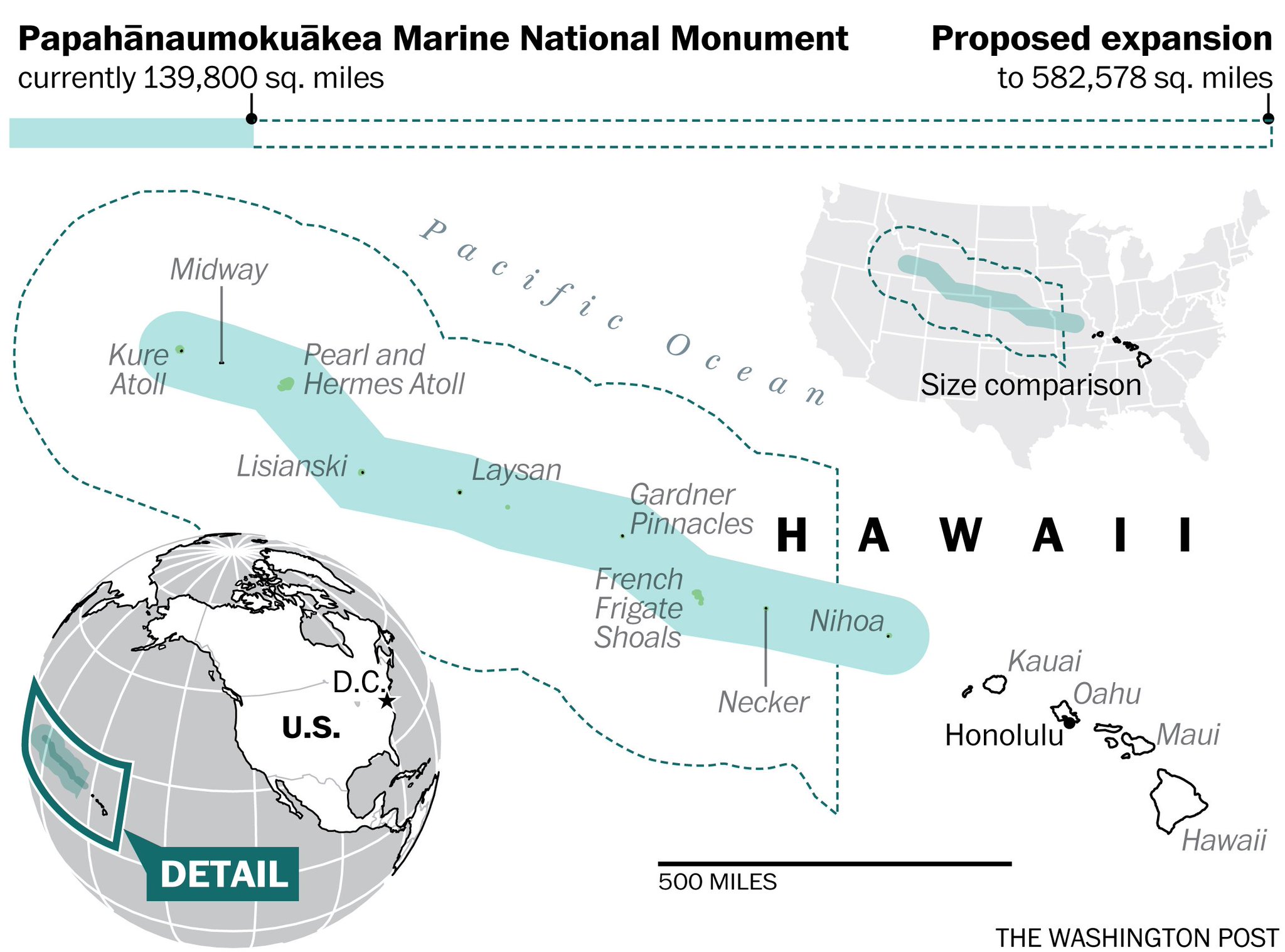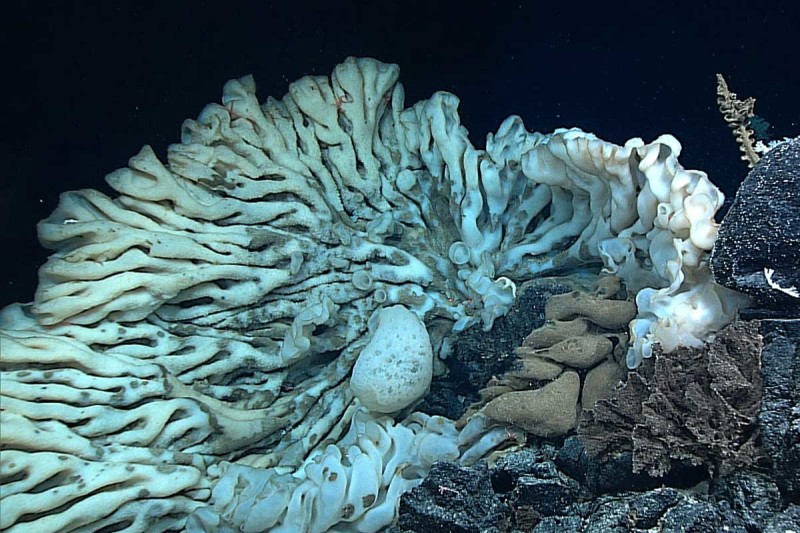The Papahanaumokuakea Marine National Monument is set to become the largest ecological preserve in the world.
A graphic from The Pew Charitable Trusts puts that size in perspective — the area will be more than 3.5 times the size of California, 10 times the size of Iowa and 105 times the size of Connecticut.
President Obama on Friday created the largest ecologically protected area on the planet when he expanded a national marine monument in his native Hawaii to encompass more than half a million square miles.
The president more than quadrupled the size of the Papahanaumokuakea (pronounced “Papa-ha-now-moh-koo-ah-kay-ah”) Marine National Monument to 582,578 square miles of land and sea in the Northwestern Hawaiian Islands.
President George W.
Bush established the monument a decade ago, but Obama’s action Friday underscores the high priority he has placed on issues of conservation and climate change in his second term.
The president has now used his executive authority under the 1906 Antiquities Act to protect more than 548 million acres of federal land and water, more than double the set-asides of any of his predecessors.

Many scientists, environmentalists and Native Hawaiians have argued for more stringent protections for the biologically rich region, given important deep-water discoveries in the area and the dual threats of climate change and sea-bed mining.
“The oceans are the untold story when it comes to climate change, and we have to feel a sense of urgency when it comes to protecting the ocean that sustains us,” said Sen.
Brian Schatz (D-Hawaii), who helped broker a compromise with groups including Native Hawaiians and day-boat fishermen.
The expansion of Papahānaumokuākea Marine National Monument, surrounding the Northwestern Hawaiian Islands, is one of the largest conservation actions in history.
The monument is now the largest protected area in the world—almost four times as large as California—measuring a total of 582,578 square miles.
Papahānaumokuākea also happens to be one of the most biologically and culturally significant places on the planet.
Papahānaumokuākea also happens to be one of the most biologically and culturally significant places on the planet.
The expansion not only creates a safe zone for the replenishment of tuna stocks and promotes biodiversity—it gives Native Hawaiians a greater voice in managing this precious resource.
source : Pew Trusts
All commercial extraction activities, including fishing and future deep-sea mining, will be prohibited in the expanded monument area.
However, recreational fishing, removal of resources for traditional Hawaiian cultural purposes and scientific research will be allowed with a federal permit.
Obama will highlight his action in an address Wednesday to the Pacific Islands Conference of Leaders and the IUCN World Conservation Congress in Honolulu, and will travel the following day to Midway Atoll, which is located within the current monument.
The president has unilaterally established more than two dozen national monuments, most of them in his second term.
White House press secretary Josh Earnest said Obama “would be happy to sign into law a piece of legislation that would have protected these waters, but we haven’t seen that kind of legislative activity in this Congress, and it means the president has had to make more effective use of his executive authority.”
Longline fishermen lobbied against any new protections, arguing that their industry rejects damaging practices such as trawling and needs flexibility to sustain an annual catch valued at more than $100 million.
“We move all over the ocean, in the way the fish move,” said Jim Cook, co-owner of POP Fishing and Marine, a Honolulu store, adding that the new restrictions mean 60 percent of federal waters off Hawaii are now closed to fishing.
With Friday’s action, seven presidents — starting with Theodore Roosevelt in 1909 — have taken steps to safeguard parts of the archipelago, which is one of the most biologically diverse areas in the world.
It is the planet’s largest seabird gathering site, with more than 14 million birds from 22 species, and is home to nearly all Laysan albatrosses and the remaining endangered Hawaiian monk seals.
This area also includes the wreckage of the USS Yorktown, which sank during the Battle of Midway in 1942 and has not been visited since it was discovered there in 1998.
Daniel Wagner, a researcher at the National Oceanic and Atmospheric Administration who served as the scientific lead for the agency’s deep-water expeditions in the region a year ago and again in February, said every one of the 50 biological samples that remotely operated vehicles recovered were either new species or “not known to live in the area.”
“We’re seeing a lot of life, a lot of new life and a lot of very old life,” he said.
“Things have not been disturbed for a very long time.”
Wagner said he is particularly concerned about future underwater mineral extraction, given the rich deposits of manganese, nickel, zinc, cobalt and titanium in the region.
“If they’re not protected, they’re going to be exposed to mining,” he said.
Matt Rand, director of the Pew Charitable Trusts’ Global Ocean Legacy program, said that intact ecosystems such as these “offer a glimpse of what our planet was like before the impacts of human activity, and it is critical that we preserve places in this way, both as a window to the past and for future generations.”
His suggestion won the support of influential state officials such as Democratic state Sen.
Ron Kouchi.
Kouchi said in an interview that he could back Obama’s expansion as long as it is the last one.
“One of the questions the fishermen are asking is, ‘When will it stop?’ ” he said.
Federal officials estimate that 5 percent of current commercial fishing efforts will be displaced.
Longline operators already catch about half their fish in international waters, and they reached their annual catch limit for big-eye tuna in early August.
However, Sean Martin, president of the Hawaii Longline Association, said the industry’s fleet of 145 boats could not match the lobbying power of well-financed environmental groups such as Pew.
“We’re obviously going up against environmental organizations that have billions of dollars,” Martin said. “For somebody to feel good, we’re going to force U.S.
fishermen out of waters.”
Republicans have accused Obama of abusing his authority under the Antiquities Act, which says any protections must “be confined to the smallest area compatible with proper care and management of the objects to be protected.”
But Richard Pyle, a researcher at Hawaii’s Bishop Museum, said he and other scientists have concluded that the ecological interconnectedess of the region — including the fish larvae that are dispersed on currents, and the sharks and other pelagic fish that travel vast distances — extends beyond federal waters.
“The minimum space necessary for protection, it’s more about 350 to 380 miles, but of course we don’t have the jurisdiction for doing so,” Pyle said.
Some Native Hawaiian activists, moreover, lobbied for greater protection so they could continue to observe traditional voyaging practices in which they navigate without instruments.
The state Department of Land and Natural Resources and the Office of Hawaiian Affairs will serve as trustees in managing the monument.
William Aila, a former state official and Hawaiian activist, said Thursday that the president’s move will preserve “a cultural seascape, with the history of the Polynesians who migrated up to Hawaii.”
He recalled that when he journeyed to Mokumanamana, or Necker Island, in 2009, “you could feel the presence of your ancestors,” not just in the earth but in “the symphony of birds, all night and all day long.”
Asked what he thought of the monument expansion, Aila switched to Hawaiian.
“Olu olu,” he said.
“In English, that’s ‘very pleasant.’ ”
Links :
- The Independant : Obama expands Hawaiian national monument, creating largest protected area on Earth
- National Geographic : National Parks Were America’s Best Idea. Let’s Bring Them Underwater / Hawaii Is Now Home to an Ocean Reserve Twice the Size of Texas
- New Scientist : This deep-sea creature could be the world’s oldest living animal
- Schmidt Ocean : Leg 1, Papahanaumokuakea Monument



No comments:
Post a Comment